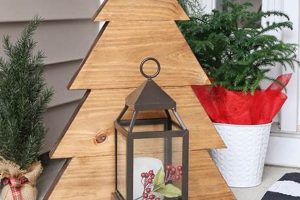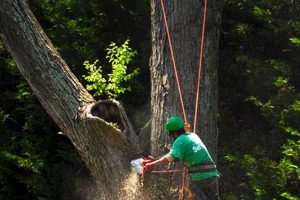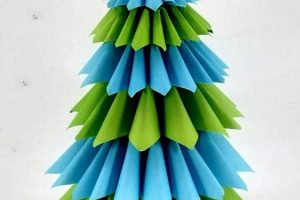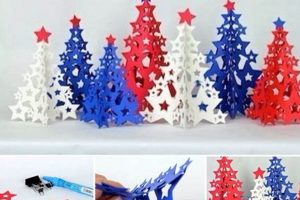Handcrafted ornaments and adornments offer a personalized approach to holiday tree embellishment. These items, often created using readily available materials and simple techniques, provide an alternative to mass-produced commercial decorations. For example, constructing paper snowflakes, painting wooden cutouts, or stringing popcorn garlands all fall under this category.
The creation of personalized holiday ornaments fosters creativity and offers an opportunity for unique expression. The resultant decorations often possess sentimental value, becoming treasured keepsakes passed down through generations. Historically, homemade decorations reflected resourcefulness and community involvement, particularly during times of economic hardship or when commercially produced items were unavailable.
The following sections will detail a variety of specific projects and techniques, focusing on different material types and skill levels. These will guide individuals in developing distinctive and personal holiday tree presentations.
Essential Guidance for Handcrafted Holiday Ornamentation
The creation of successful handcrafted ornaments requires careful planning and execution. The following guidelines will improve the quality and longevity of self-made holiday decorations.
Tip 1: Material Selection. Choose materials appropriate for the desired aesthetic and durability. Natural materials like wood or dried citrus provide rustic charm, while fabrics and felt offer opportunities for intricate designs. Ensure materials are non-toxic, particularly if children or pets are present.
Tip 2: Secure Attachment Mechanisms. Implement robust attachment methods. Weak glue or flimsy wire can lead to ornaments detaching and potentially breaking. Utilize sturdy hooks, strong twine, or appropriately sized wire for secure hanging.
Tip 3: Consider Ornament Weight. Heavier ornaments should be placed on stronger branches closer to the tree’s trunk. Distribute weight evenly to prevent branch drooping or damage to the tree. Lightweight materials are generally preferable for smaller or weaker branches.
Tip 4: Preservation and Storage. After the holiday season, store ornaments in acid-free containers in a cool, dry place. Wrap delicate items individually in tissue paper or bubble wrap to prevent damage during storage. Proper preservation ensures the longevity of handcrafted items.
Tip 5: Pre-Planning and Design. Before commencing construction, create a design plan. Sketch out ornament ideas, noting dimensions, materials, and color schemes. Pre-planning streamlines the process and ensures a cohesive aesthetic across all decorations.
Tip 6: Sealing and Protecting. To increase the lifespan of ornaments, consider applying a sealant or protective coating. For painted ornaments, a clear varnish can prevent chipping. Fabric ornaments may benefit from a fabric sealant to prevent fraying.
Effective application of these guidelines will contribute to the creation of visually appealing, durable, and cherished holiday decorations.
The subsequent sections will address specific project ideas and offer more detailed instructions on various ornamentation techniques.
1. Material Sustainability in DIY Tree Decorations
The integration of material sustainability into the creation of handcrafted holiday tree ornaments represents a conscious effort to minimize environmental impact while fostering creativity and personalization.
- Recycled Paper and Cardboard Utilization
Employing recycled paper and cardboard diverts waste from landfills and reduces the demand for virgin paper pulp. Examples include crafting paper snowflakes, creating decorative boxes, or repurposing cardboard tubes into miniature figures. The environmental implication is a decrease in deforestation and a reduction in the energy required for paper production.
- Natural and Biodegradable Materials Sourcing
Sourcing natural and biodegradable materials, such as wood scraps, dried flowers, or fallen leaves, minimizes reliance on synthetic or resource-intensive alternatives. The use of pinecones, for instance, offers a rustic aesthetic while avoiding the environmental burden associated with plastic ornaments. This approach diminishes the accumulation of non-biodegradable waste in landfills.
- Upcycled Fabric and Textiles Incorporation
Incorporating upcycled fabrics and textiles repurposes existing materials, extending their lifespan and reducing textile waste. Scraps of fabric from old clothing or linens can be transformed into quilted ornaments or fabric-covered balls. The benefit is a decreased demand for new textile production, which is a water- and energy-intensive process.
- Non-Toxic and Eco-Friendly Adhesive Selection
The selection of non-toxic and eco-friendly adhesives ensures the safety of the environment and those crafting the ornaments. Using plant-based glues or natural adhesives avoids the release of harmful chemicals associated with conventional adhesives. This promotes a healthier indoor environment and reduces the risk of water and soil contamination.
The integration of these facets into the creation of self-made holiday decorations demonstrates a commitment to environmental stewardship. Through mindful material selection and responsible disposal practices, the creation of ornaments can be both a creative and sustainable endeavor.
2. Design originality
Design originality in the context of self-made holiday ornaments represents a divergence from standardized, commercially produced decorations. It allows for personalized expression and the creation of distinctive items that reflect individual aesthetics and values.
- Personalized Thematic Development
Personalized thematic development enables the creation of ornaments aligned with specific interests, hobbies, or memories. For example, a miniature sailboat for a sailing enthusiast or a book-shaped ornament for a literature lover. This fosters a deeper connection with the decorations and enhances their sentimental value.
- Innovative Material Combination
Innovative material combination involves the unconventional pairing of materials to achieve unique textures and visual effects. Examples include incorporating found objects, such as sea glass or metal scraps, or combining traditional craft materials like yarn and felt in unexpected ways. This results in ornaments that are visually stimulating and one-of-a-kind.
- Adaptation of Traditional Techniques
Adaptation of traditional techniques entails modifying established craft methods to create novel ornament designs. For example, adapting origami techniques to create three-dimensional paper ornaments or using cross-stitch to create miniature portraits. This approach blends familiar skills with innovative design, resulting in unique and intricate decorations.
- Incorporation of Symbolic Elements
Incorporation of symbolic elements imbues ornaments with deeper meaning and personal significance. Examples include using specific colors to represent emotions or incorporating symbols that reflect personal values or beliefs. This adds a layer of depth and complexity to the decorations, making them more than just decorative items.
These facets of design originality contribute to the creation of holiday decorations that are not only visually appealing but also imbued with personal meaning and creativity. By embracing originality, individuals can transform ordinary materials into cherished keepsakes that reflect their unique perspectives and experiences. The pursuit of design originality elevates the self-made ornament from a simple craft project to a form of personal artistic expression, adding depth and significance to the holiday season.
3. Construction durability
Construction durability is a critical attribute of handcrafted holiday tree ornaments, directly impacting their longevity and continued aesthetic value. The chosen construction methods and materials determine the ornament’s resistance to physical stresses, environmental factors, and the passage of time. Inadequate construction can result in damage during storage, handling, or display, diminishing the ornament’s sentimental and decorative value. For example, an ornament made with poorly adhered components may disintegrate over time, while one crafted from fragile materials may shatter easily.
The selection of appropriate adhesives, secure attachment mechanisms, and robust materials contributes directly to construction durability. The use of acid-free archival glues ensures that components remain bonded without deterioration, while properly reinforced hanging loops prevent detachment. Durable materials, such as weather-resistant wood or tightly woven fabrics, withstand environmental factors such as humidity and temperature fluctuations. Applying protective finishes such as varnish or sealant on fragile materials enhances durability and ensures structural integrity. A practical example is an ornament made using polymer clay that has been properly baked and sealed, providing greater resistance to breakage.
Understanding the connection between construction durability and self-made holiday ornaments is essential for ensuring that these items become cherished keepsakes passed down through generations. Careful attention to construction techniques and material selection during the creation process contributes to the ornament’s longevity and preservation, maintaining its significance as a symbol of holiday tradition and personal expression. Neglecting durability may lead to premature degradation, diminishing both the physical and emotional value associated with handcrafted decorations.
4. Hanging stability
Hanging stability, the characteristic of remaining securely attached to the tree branch without undue movement or dislodgment, directly impacts the visual presentation and preservation of handmade ornaments. Inadequate stability compromises the aesthetic arrangement and increases the risk of breakage. For example, a poorly secured ornament may swing excessively, disrupting the tree’s visual balance, or fall to the ground, resulting in damage or loss.
Factors influencing hanging stability include ornament weight, attachment method, and branch strength. Lightweight ornaments with sturdy hanging loops or well-attached hooks exhibit greater stability, while heavy ornaments with flimsy attachments are prone to instability. Distribution of ornament weight across the tree, with heavier items placed on stronger, lower branches, mitigates the risk of branch drooping and enhances overall stability. A practical consideration involves selecting appropriate hanging mechanisms based on ornament weight and branch diameter.
The importance of hanging stability lies in maintaining the integrity and visual appeal of self-made holiday decorations. Secured ornaments prevent accidents, preserve the items’ condition, and contribute to the tree’s overall aesthetic coherence. Understanding and addressing factors impacting stability is vital for the effective display and long-term preservation of handcrafted ornamentation, adding to the tradition of the holiday season.
5. Aesthetic Coherence
Aesthetic coherence, in the context of self-made holiday tree ornaments, signifies the harmonious arrangement of decorative elements to achieve a unified and visually pleasing appearance. This principle ensures that individual ornaments, while potentially diverse in design, collectively contribute to a balanced and purposeful aesthetic theme. Consideration of color palettes, material consistency, and stylistic unity are crucial components of aesthetic coherence.
- Color Palette Consistency
The selection and consistent application of a restricted color palette establish visual harmony. This may involve choosing complementary colors, analogous colors, or a monochromatic scheme. For example, a tree adorned with ornaments utilizing varying shades of blue, silver, and white creates a cohesive and calming aesthetic. This intentional limitation avoids visual clutter and promotes a sense of visual unity.
- Material Uniformity
Employing similar materials, or materials that complement each other, contributes to aesthetic coherence. This does not necessitate using identical materials for all ornaments, but rather ensuring that the materials chosen possess a complementary texture, sheen, or weight. A tree decorated with a mix of felt, wooden, and metallic ornaments, all sharing a matte finish, would exhibit greater material uniformity than a tree mixing high-gloss plastic with rustic burlap.
- Stylistic Unity
Adhering to a specific design style, such as minimalist, rustic, vintage, or contemporary, provides stylistic unity. This involves ensuring that the shapes, patterns, and overall design of the ornaments align with the chosen style. For instance, a tree decorated with ornaments featuring clean lines, geometric shapes, and neutral colors aligns with a minimalist aesthetic. This consistent stylistic approach avoids visual discord and reinforces the intended design theme.
- Scale and Proportion Balance
Maintaining a balance in scale and proportion among the ornaments contributes to visual harmony. This involves ensuring that the sizes of the ornaments are proportionate to the size of the tree and to each other. Overly large ornaments can overwhelm smaller branches, while excessively small ornaments may become visually lost. Achieving a balance in scale creates a more visually appealing and balanced display.
The deliberate application of these facets promotes aesthetic coherence within a handcrafted holiday tree ornament collection. This focus on visual harmony enhances the overall presentation, transforming individual ornaments into a unified and visually impactful decorative display. The achievement of aesthetic coherence requires thoughtful planning and execution, leading to a more sophisticated and pleasing result.
6. Storage practicality
Storage practicality, pertaining to self-made holiday ornaments, defines the ease and efficiency with which these items can be preserved and protected during the off-season. This facet is crucial for maintaining the longevity and aesthetic quality of handcrafted decorations, ensuring their availability for future use.
- Compact Size and Stackability
Ornament designs that prioritize compact size and stackability optimize storage space. For example, flat, two-dimensional ornaments or those designed to nest within each other reduce the volume required for storage. This is especially relevant for individuals with limited storage capacity. A practical implication includes crafting ornaments that disassemble into smaller components for off-season packing.
- Durable Material Selection
Choosing robust materials that withstand storage conditions is essential for preservation. Ornament materials susceptible to moisture, insect damage, or physical deformation pose storage challenges. Selecting materials such as treated wood, sealed glass, or dense fabrics enhances resilience during storage. The material selection also directly affects the necessary storage conditions, potentially requiring climate control or specialized containers.
- Protective Container Compatibility
Ornament designs should accommodate readily available and protective storage containers. Fragile or intricate ornaments benefit from custom-fit containers or dividers to prevent damage. Designs that allow for easy placement and retrieval from containers facilitate efficient storage practices. Consideration should also be given to container materials, favoring acid-free options to prevent material degradation.
- Simplified Cleaning Requirements
Ornament designs that minimize dust accumulation and simplify cleaning procedures improve storage practicality. Complex or textured ornaments often attract dust, requiring specialized cleaning techniques before and after storage. Designs that are easily wiped down or vacuumed reduce maintenance demands and prevent long-term deterioration. Smooth, sealed surfaces are advantageous in minimizing cleaning needs.
Effective integration of these facets into ornament design significantly improves storage practicality. This, in turn, contributes to the long-term preservation of self-made holiday decorations, ensuring their continued enjoyment across successive seasons. Attention to storage practicality is not merely a logistical consideration but a crucial element in sustaining the value and sentimentality associated with handcrafted ornaments.
Frequently Asked Questions
The following addresses common inquiries regarding the creation and preservation of self-made holiday tree adornments. Answers are provided to ensure informed decision-making and maximize the longevity of handcrafted items.
Question 1: What materials are most suitable for creating durable self-made ornaments?
Materials exhibiting inherent resilience, such as kiln-dried wood, dense felt, and weather-resistant metals, provide optimal durability. Appropriate material selection is crucial for withstanding storage conditions and preventing damage during display. Consideration should be given to long-term material stability and resistance to environmental factors.
Question 2: How can ornament weight be managed to prevent branch drooping?
Strategic weight distribution is essential. Heavier ornaments should be positioned on stronger, lower branches closer to the tree’s trunk. Lightweight materials are preferable for delicate or upper branches. Employing lightweight fillers, such as polystyrene or hollow forms, can reduce ornament mass without compromising visual appeal.
Question 3: What adhesives are recommended for ensuring secure attachment of ornament components?
Acid-free archival glues and epoxy resins provide superior bonding strength and longevity. Hot glue may be suitable for certain applications but is generally less durable and prone to weakening over time. Adhesives should be selected based on the specific materials being joined and their respective properties.
Question 4: How can intricate ornament designs be protected during storage?
Individual wrapping in acid-free tissue paper or bubble wrap is recommended for delicate items. Custom-fit storage containers with compartmentalized dividers prevent contact and reduce the risk of breakage. Proper storage in a cool, dry environment minimizes the potential for material degradation.
Question 5: What cleaning methods are appropriate for maintaining the aesthetic quality of self-made ornaments?
Gentle dusting with a soft brush or microfiber cloth is generally sufficient for removing surface debris. Avoid abrasive cleaners or harsh chemicals that may damage delicate materials or finishes. Spot cleaning with a damp cloth and mild detergent is appropriate for localized stains or blemishes.
Question 6: How can design originality be balanced with aesthetic coherence within a collection of self-made ornaments?
Establishing a unifying theme or color palette can maintain aesthetic coherence while allowing for individual design expression. Variation in ornament shape, size, and material is acceptable, provided that the overall aesthetic aligns with the established theme. Intentional repetition of design elements can also reinforce visual unity.
Careful consideration of these factors will contribute to the successful creation and long-term preservation of self-made holiday tree decorations, ensuring their continued enjoyment for years to come.
The subsequent section will provide specific project ideas and step-by-step instructions for creating various types of holiday ornaments.
Conclusion
This exploration has addressed critical facets of handmade holiday tree adornments, emphasizing material sustainability, design originality, construction durability, hanging stability, aesthetic coherence, and storage practicality. These elements collectively define the quality and longevity of such creations, impacting both their visual appeal and sentimental value.
The successful implementation of these principles ensures that self-made decorations transcend mere ornamentation, becoming enduring symbols of tradition and personal expression. Future endeavors in this field should prioritize innovation in sustainable practices and preservation techniques to further enhance the significance of handcrafted holiday items.







